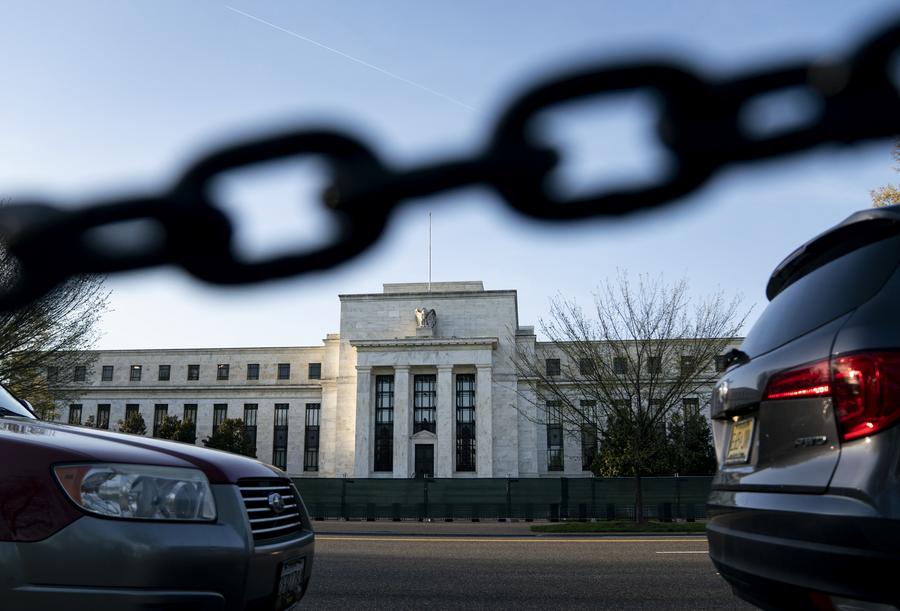from ABS-CBN News
The Fed Cut the Interest Rate to Bail Out the Treasury
by Daniel Lacalle
Mises.org
 The Federal Reserve decided to cut rates by 50 basis points despite what Chairman Powell considers “no risk of a recession or downturn,” a “solid economy,” and a “strong job market.”
The Federal Reserve decided to cut rates by 50 basis points despite what Chairman Powell considers “no risk of a recession or downturn,” a “solid economy,” and a “strong job market.”
After ignoring the impact of monetary aggregates and the warning signs of inflation, the Federal Reserve has breached its price stability mandate for three consecutive years, preferring to prioritize liquidity injections, i.e., printing money, to the recovery of the currency’s purchasing power.
The “higher for longer” policy only lasted eighteen months. Furthermore, the latest reading of the Chicago Fed National Financial Conditions Index indicates extremely loose conditions. In fact, the Fed has never cut rates by so much when financial conditions have been this loose.
This Chart Shows Gold vs. the Stock Market Since Bernanke’s Famous ‘Helicopter Drop’ Speech
Morgan Stanley says lower-quality stocks and commodities will struggle during heavy fiscal spending
by Steve Goldstein
Market Watch

Then, Bernanke noted, gold traded at $300 an ounce. Last week, gold reached a new record high of $2,619.90 an ounce. That is better than the S&P 500 since Bernanke’s speech and most other assets as well.
Dow Jones Rises as Inflation Report Looms; GM Slides On Downgrade
by Scott Lehtonen
Investor’s Business Daily
 The Dow Jones Industrial Average and the other major stock indexes rose modestly Monday after factory data, while a critical inflation report looms later in the week. An early mover on the stock market today was General Motors (GM), which dropped on an analyst downgrade.
The Dow Jones Industrial Average and the other major stock indexes rose modestly Monday after factory data, while a critical inflation report looms later in the week. An early mover on the stock market today was General Motors (GM), which dropped on an analyst downgrade.
After the opening bell, the Dow Jones Industrial Average rose less than 0.1%, while the S&P 500 gained 0.2%. The tech-heavy Nasdaq composite moved up 0.3% in early trading.
Early Monday, the 10-year Treasury yield ticked higher to 3.77%. Oil prices rose, with West Texas Intermediate futures trading around $71.15 per barrel.
Among exchange traded funds, the Invesco QQQ Trust (QQQ) was up 0.3%, as the SPDR S&P 500 ETF (SPY) moved up 0.2% after the open.
Interview: Market Jitters as Fed’s Rate Cut Heightens Inflation Concerns, Says Analyst
by Xinhua
News.cn
 Even if the United States reaches an inflation rate of 2 percent, the purchasing power of the public, household inflation, and the overall purchasing power of money would not return to previous levels, a Turkish analyst said.
Even if the United States reaches an inflation rate of 2 percent, the purchasing power of the public, household inflation, and the overall purchasing power of money would not return to previous levels, a Turkish analyst said.
ISTANBUL, Sept. 24 (Xinhua) — Market participants remain uneasy as the U.S. Federal Reserve cut interest rates by 50 basis points on Wednesday, amidst growing uncertainties in the U.S. economy, said a Turkish analyst.
Typically, when markets receive more than expected — like a 50-basis point cut instead of a 25-basis point — it should generate positivity, Murat Tufan, an analyst with the EkoTurk broadcaster, told Xinhua in a recent interview.
Why China’s Economic Slowdown is Unlikely to Affect U.S. Inflation
by Josh Lipton and Madison Mills
Yahoo! Finance
Unlimited Co-founder, CEO, and chief investment officer Bob Elliott joins Josh Lipton and Madison Mills on Market Domination after last week’s rate cut to discuss some of the top stories of the day, including concerns about the Chinese economy and rising gold prices, breaking down what investors need to know.
Elliot tells investors the state of China’s economy is “not likely to have a meaningful impact on US inflation numbers ahead; when it comes to growth, the US economy is pretty insulated from Chinese growth and not likely to have much of an impact.”
In regard to the impact on oil prices, Elliot says, “We’re really in this range here on oil (CL=F) where we’re not likely to see meaningfully more elevated oil prices, nor meaningfully lower oil prices ahead.
Days After Rate Cut, S&P’s Flash PMI Sees Rising Inflation and Exhorts the Fed to “Move Cautiously” with “Further Rate Cuts”
by Wolf Richter
Wolf Street
 “The “reacceleration of inflation” suggests “the Fed cannot totally shift its focus away from its inflation target.”
“The “reacceleration of inflation” suggests “the Fed cannot totally shift its focus away from its inflation target.”
Underlying inflationary dynamics are picking up steam, after having cooled a lot. Today, S&P’s preliminary Flash US Composite PMI (Purchasing Manager Index), based on data collected from September 12 through 20, entailed multiple warnings about the Fed’s future rate cuts, in light of reaccelerating selling-price inflation in both the services and manufacturing sectors, and in light of input-cost inflation in services.
Stagflation Economy: U.S. Manufacturing Collapse Remains as Stagflation Rules the Day
from King World News
 As we kickoff another trading week, the US manufacturing collapse continues as stagflation rules the day.
As we kickoff another trading week, the US manufacturing collapse continues as stagflation rules the day.
September 23 (King World News) – Peter Boockvar: The September US PMI fell a touch to 54.4 from 54.6 with manufacturing remaining weak at 47 vs 47.9 in August, the slowest since June 2023…
US Manufacturing Collapse Remains As Stagflation Rules The Day
Cheapflation and the Rise of Inflation Inequality in 2021-2023
by Tao Chen, Peter Levell, and Martin O’Connell
CEPR
 Inflation rates soared over the period 2021-2023, driving down households’ real incomes in the UK and other countries. This column uses detailed data on price and spending patterns for groceries to assess the relative impacts of inflation across rich and poor households. Significant differences in grocery price inflation experienced by rich and poor households only emerge once the most disaggregated product definitions are used. Price increases were disproportionately large for individual varieties of products that were initially cheaper (‘cheapflation’), driving up inflation rates for worse-off households.
Inflation rates soared over the period 2021-2023, driving down households’ real incomes in the UK and other countries. This column uses detailed data on price and spending patterns for groceries to assess the relative impacts of inflation across rich and poor households. Significant differences in grocery price inflation experienced by rich and poor households only emerge once the most disaggregated product definitions are used. Price increases were disproportionately large for individual varieties of products that were initially cheaper (‘cheapflation’), driving up inflation rates for worse-off households.
Fed Cuts 0.5%, Gold Makes a New High, and Dollar Confidence Collapses
Gold prices hit new highs amid declining confidence in the USD, as capital flows shift away from the dollar. The Fed’s rate cut sparks concerns over potential election interference.
by Dave Fairtex
Chris Martenson’s Peak Prosperity
 I took a peek down the inflation rabbit hole this week because some folks thought that the tiny increase in Retail Sales was fantastic (because – dropping prices!). Unfortunately, those “dropping prices” metrics were provided by the BLS. John Williams at shadowstats.com provides a CPI that’s calculated using the same method used back in the Carter days. Carter (probably) lost the 1980 election because of the then-15% inflation, so his successors (appear to have) progressively “fixed” inflation calculations so this unfortunate reveal wouldn’t happen again. Call it: government-gaslighting, which has just grown worse over time, as revealed to us by John Williams. Long story short: inflation is massively underestimated by about 6-8% annually, vs calculations used in Carter-1980. As a result, the Fed’s “2% inflation target” is actually a 9% inflation target. Quite literally, “the system” has been busy making sure that “You Will Own Nothing” over the past 20 years. And if you do accidentally own something – cap gains taxes will “fix” the problem. “Sell your Dad’s farm to pay the taxes – to Billy Gates who got even richer off the DeathVax!”
I took a peek down the inflation rabbit hole this week because some folks thought that the tiny increase in Retail Sales was fantastic (because – dropping prices!). Unfortunately, those “dropping prices” metrics were provided by the BLS. John Williams at shadowstats.com provides a CPI that’s calculated using the same method used back in the Carter days. Carter (probably) lost the 1980 election because of the then-15% inflation, so his successors (appear to have) progressively “fixed” inflation calculations so this unfortunate reveal wouldn’t happen again. Call it: government-gaslighting, which has just grown worse over time, as revealed to us by John Williams. Long story short: inflation is massively underestimated by about 6-8% annually, vs calculations used in Carter-1980. As a result, the Fed’s “2% inflation target” is actually a 9% inflation target. Quite literally, “the system” has been busy making sure that “You Will Own Nothing” over the past 20 years. And if you do accidentally own something – cap gains taxes will “fix” the problem. “Sell your Dad’s farm to pay the taxes – to Billy Gates who got even richer off the DeathVax!”
The Yield Curve Before & After the Rate Cut: Why Have Longer-Term Yields Risen since the Rate Cut? Already Priced in? Inflation Concerns as Policy Loosens in a Decent Economy?
by Wolf Richter
Wolf Street
 Mortgage rates also ticked up.
Mortgage rates also ticked up.
The Treasury yield curve is un-inverting piece by piece, but not in the way future homebuyers want: before and since the rate cut, shorter-term Treasury yields have fallen, driven by the Fed’s actual and expected rate cuts; but longer-term Treasury yields and mortgage rates have inched up.
As shorter-term yields drop while longer-term yields rise – or fall more slowly than shorter-term yields – the yield curve un-inverts step by step and eventually enters its normal state where all shorter-term yields are lower than longer-term yields.
But it still has a long way to go before it’s un-inverted all the way, to where shorter-term yields are lower than longer-term yields across the yield curve.
